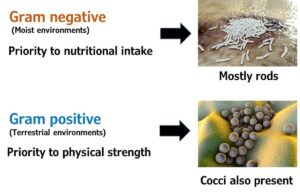Introduction to Food Microbiology
Food Microbiology: Understanding the Human-Microbe Battle
In this article, aimed at beginners in the fields of food microbiology and microbiology, I will explain the relationship between foodborne pathogens, spoilage bacteria, and humans. From the perspective of utilizing stellar energy, both humans and microorganisms are considered losers compared to plants. This is because unlike plants, they cannot convert solar energy into chemical energy. From the viewpoint of extraterrestrials, plants may be the life forms worthy of respect, while humans and microorganisms might be seen as similar and inferior creatures. Therefore, food microbiology can be seen as a discipline that studies the battle between losers in terrestrial biology from an energy perspective.
Essential Guide to the Oxidase Test: Key Method for Identifying Gram-Negative Bacteria, Including Enterobacteriaceae
This article provides a comprehensive overview of the oxidase test, including its mechanism, principles, testing methods, and significance in detecting Gram-negative bacteria, particularly Enterobacteriaceae. We'll delve into how the test works, what it reveals, and precautions to take to avoid false positive results. Additionally, we'll explore the importance of the oxidase test in food hygiene and its relevance in testing for Enterobacteriaceae.
Mastering the OF Test: A Guide to Understanding Gram-Negative Bacteria in Food Safety
How can we identify and differentiate bacteria, especially when it comes to ensuring food safety? The Oxidation-Fermentation (OF) Test is a simple yet powerful tool used in microbiology to classify bacteria based on their oxygen and glucose usage. This article will guide you through its purpose, process, and importance for food safety professionals.
Unlocking the Secrets: How Oxygen Impacts Microbial Growth - A Guide for Food Microbiology Beginners!
When studying food microbiology, it's essential to understand the growth patterns of bacteria, especially if you identify them as Gram-negative bacilli. A significant differentiation is whether they are aerobic bacteria or facultative anaerobic bacteria. In this article, I will be breaking down this relationship between bacterial growth and oxygen. We'll explore the glycolytic pathway, the citric acid cycle (or TCA cycle), and the electron transport chain. Additionally, I'll explain what aerobic bacteria, facultative anaerobic bacteria, and strict anaerobic bacteria are.
Why Are Gram-Negative Bacteria Mostly Rods? Exploring Cocci and Rods in Food Microbiology
In microbiology, one of the fundamental lessons is distinguishing between cocci and rods. But have you ever wondered why Gram-negative bacteria in food microbiology are predominantly rod-shaped? This article explores the fascinating reasons behind bacterial shapes, from nutrient uptake to environmental adaptation, revealing why cocci are rare among Gram-negative bacteria.
Organising Gram-Negative and Gram-Positive Bacteria: A Guide for Food Microbiology
In recent years, species identification based on 16S rRNA gene analysis has become increasingly popular. As a result, bacterial classification has become more intricate and complex. However, in the field of food microbiology, it is essential to grasp the broader framework before delving into detailed classifications. In a series of upcoming articles, I would like to discuss the microbial classification method, which serves as a useful mental toolbox for organizing and memorizing various Gram-negative and Gram-positive bacteria commonly encountered in food microbiology. The composition of this mental toolbox differs slightly between Gram-positive and Gram-negative bacteria, making it advantageous to internalize these frameworks.
E. coli O157: Why Only Humans Suffer Foodborne Illness While Cattle Remain Unharmed?
As a university professor specialising in food microbiology, I often address a compelling question: Why does E. coli O157 cause foodborne illness in humans while cattle remain unharmed? This curious phenomenon challenges our human-centric perspective on microbial relationships. In this article, we will delve into the complexities of this issue, exploring how E. coli O157 interacts with its hosts within the broader context of Earth's biological diversity. Join me as we uncover the interconnected narratives of microbes and their hosts, revealing insights that might shift our understanding of foodborne illnesses.
Microorganisms and Humanity: A Brief Encounter in Earth's 4-Billion-Year History
When studying food microbiology, it’s easy to focus solely on pathogenic microorganisms and their impact on humans. However, this perspective misses the bigger picture. In this article, we’ll explore humanity’s place in Earth’s 4-billion-year microbial history and challenge the human-centric view of microorganisms.







